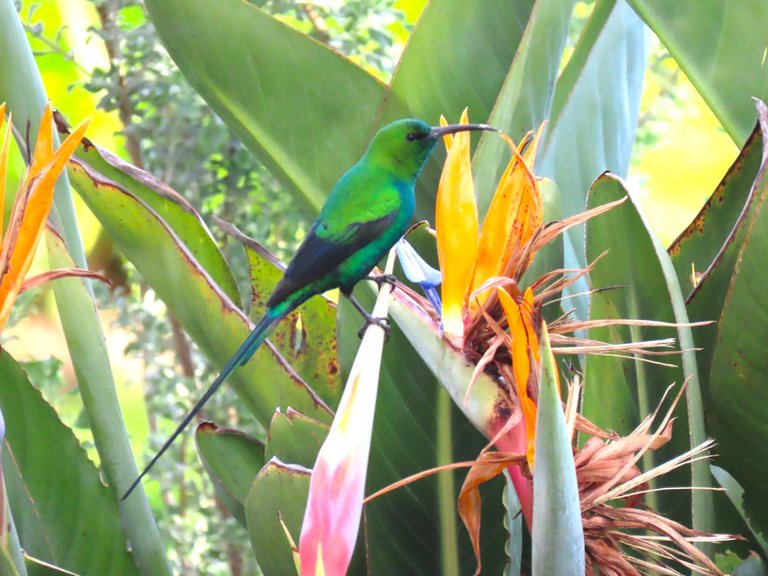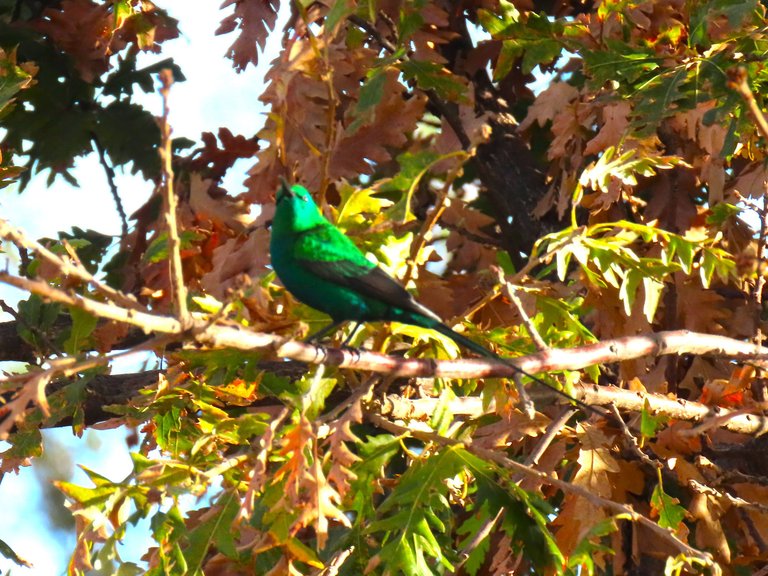The winter is their time for love.
Yes, it is now winter here in South Africa, and the trees and vines are also resting.

But of course, the winter also has new life appearing, such as the young Malachite sunbirds.
We often visit the wine farm, and I especially search for the young sunbirds, as they were born in the late winter season last year. The summer gives them enough time to grow enough, so that they can endure their first winter. The males are also now searching for wives, so that their babies can be born during the last part of the winter this year. Now they will repeat the cycle and at winter next year, we will see the new ones replicating the cycle. Amazing how they can do this on instinct, but then again, nature has many such incidents.
You can see that the male is dressed in his breeding suit. This is a Malachite Sunbird (Nectarinia Famosa).
By now, some of my regular readers will know that I love the Malachites, but for those that do not know the Malachites, a quick explanation.
The malachite sunbird (Nectarinia famosa) is a small nectarivorous bird found from the highlands of Ethiopia southwards to South Africa. They pollinate many flowering plants, particularly those with long corolla tubes, in the Fynbos.
The sunbirds are a group of small Old World passerine birds, and are placed within the family Nectariniidae, which is found across Africa, the Middle East and into South-east Asia. Also called green sugarbird.
The malachite sunbird has two subspecies. The nominate N. f. famosa occurs mainly in South Africa, Lesotho and western Eswatini, although its range just extends into southern Namibia and Zimbabwe. N. f. cupreonitens breeds in the highlands from Ethiopia south to northern Mozambique.
Now look carefully and you will see how the male at the bottom is eyeing the girl above :)
I wonder if mankind was also programmed to only pair in winter what would happen. Everyone's babies will be born during the winter months and the toy and baby shops will riot, as the rest of the year they will have no business. Just one of my weird thoughts and I hope that some chip happy scientist won't read this, as then he could get the idea for chip implants to control human populations. I like to have fun in my posts and sometimes I even get a smile.
In the meantime, I have taken shots of another scoop and here below is a teaser to show you what I will post soon.
For now, I say adios and I hope that you enjoyed the pictures.
Photos by Zac Smith-All Rights Reserved.
Camera: Canon PowershotSX70HS Bridge camera.
Thank you kindly for supporting this post.









These photos are truly beautiful. I'm not a bird fancier, and I'd be lying to you if I said I was. But I assume that taking pictures of birds is a very difficult task and you did great.
Thank you and I love everything in nature. A lot of practice has honed my photographical skills.
!PIZZA
What gorgeous little birds! The males have such vibrant colors, interesting that they couple up in winter though. Most birds prefer spring!
Last things we need is to have everyone having babies at the same time, imagine the poor hospital workers at that time of year....
What a beautiful bird of prey, you got some great shots in there!
Thank you, they are nectar feeders and the protea and pin-cushion flowers that they love only bloom in winter. The babies are born close to the end of winter.
Haha, I was only fooling around a bit, but you are right as the hospitals will have to run a similar production line like a polony factory !LOL
I was so grateful to get some shots of that junior Harrier Hawk.
!BEER
lolztoken.com
Because it was mugged.
Credit: reddit
@thebighigg, I sent you an $LOLZ on behalf of papilloncharity
(2/10)
NEW: Join LOLZ's Daily Earn and Burn Contest and win $LOLZ
View or trade
BEER.Hey @thebighigg, here is a little bit of
BEERfrom @papilloncharity for you. Enjoy it!Learn how to earn FREE BEER each day by staking your
BEER.$PIZZA slices delivered:
papilloncharity tipped hecatonquirox
@papilloncharity(1/15) tipped @waldelgado
Great and amazing captures! 👏👏👏
Thank you for the appreciation!
!PIZZA
I love birds, I know the long billed bird as a hummingbird, maybe I'm wrong, at least I know that it is difficult to take pictures of them, but you do it very naturally, thanks for your beautiful pictures.
Thank you, and no, we don't have hummingbirds here in South Africa. But we have many species of the sunbirds. When I started with photography, a friend suggested that I should practice to get dragonflies in flight, and it was the best advice, as if one can successfully get dragonflies, then the bigger things are easier.
!BEER
View or trade
BEER.Hey @equipodelta, here is a little bit of
BEERfrom @papilloncharity for you. Enjoy it!Did you know that <a href='https://dcity.io/cityyou can use BEER at dCity game to buy cards to rule the world.
Never ceases to amaze me, birds.
Great shots. Totally thought it was a hummingbird. Interesting that it's called a malachite, like the stone malachite!! Looks like the stone too.
Please forgive the assertiveness:
Right now, I'm promoting (not a bot) @currentxchange's DHF proposal to people I think would be interested. More than half the HBD goes to rewarding music posts. If you're interested to learn what we're building with the other part of the funds, click the image